TL;DR
Therapeutic gardening can reduce stress, improve mood, and create routine, even in small spaces. Use these healing garden design ideas to learn how to create a healing garden at home with low-maintenance plants, native landscaping, and container gardening that fits your climate and schedule.
Why Gardening And Mental Health Belong Together
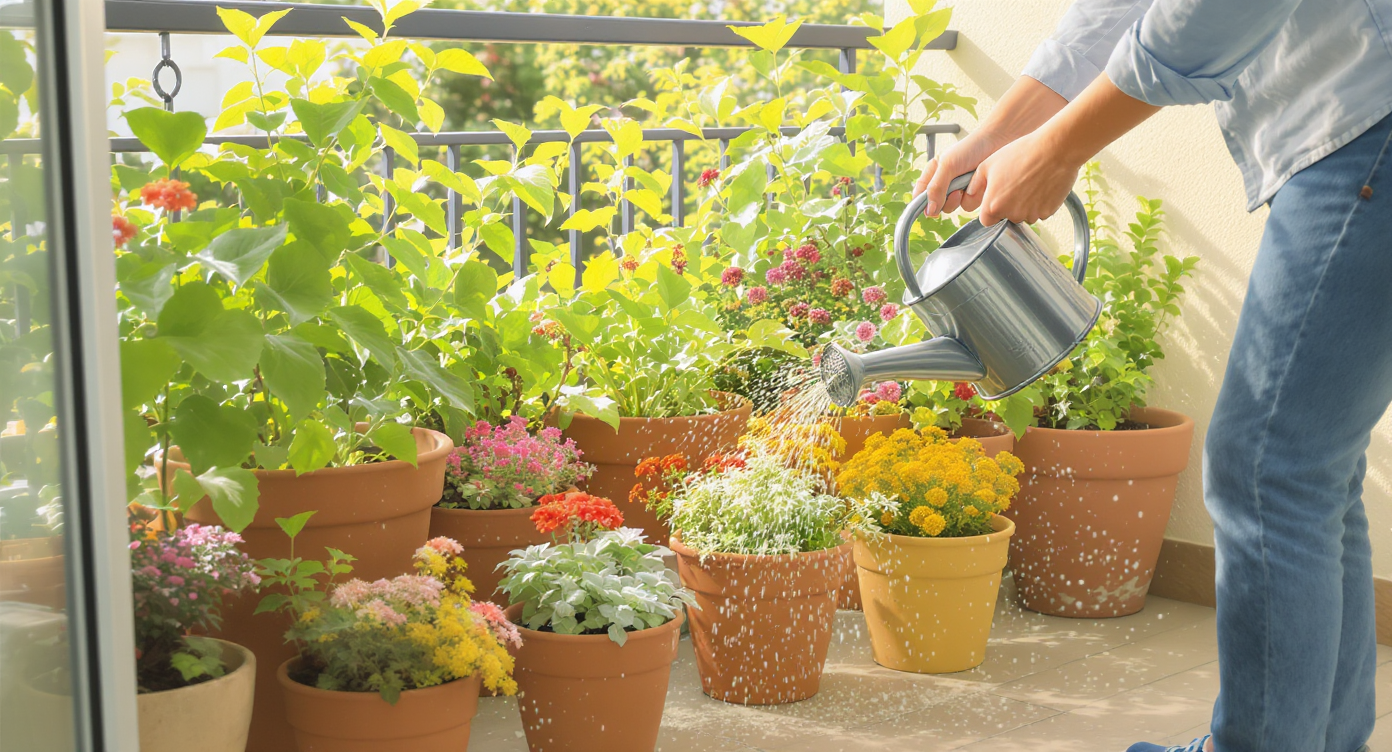
Container gardening on patios and balconies offers mental health benefits in limited spaces.
Most people experience noticeable stress relief after 15–20 minutes of light garden tasks like watering or weeding. Over the past few years, I’ve watched homeowners and apartment dwellers alike turn to therapeutic gardening for steadier days and better sleep. The shift isn’t just about pretty borders. It’s about a place to move your body, notice sunlight, and make small decisions that add up to calm. Gardening and mental health are linked by routine—the kind that starts with checking soil moisture and ends with a handful of basil for dinner. On neighborhood walks, I see backyard design changing: fewer clipped edges, more native landscaping, softer paths, and container gardening on porches where full gardens won’t fit. Here’s why that matters: you don’t need a perfect yard to feel better, you just need one that supports you on rough days and meets you with easy wins on good ones.
From Trend To Toolkit: What A Healing Garden Does
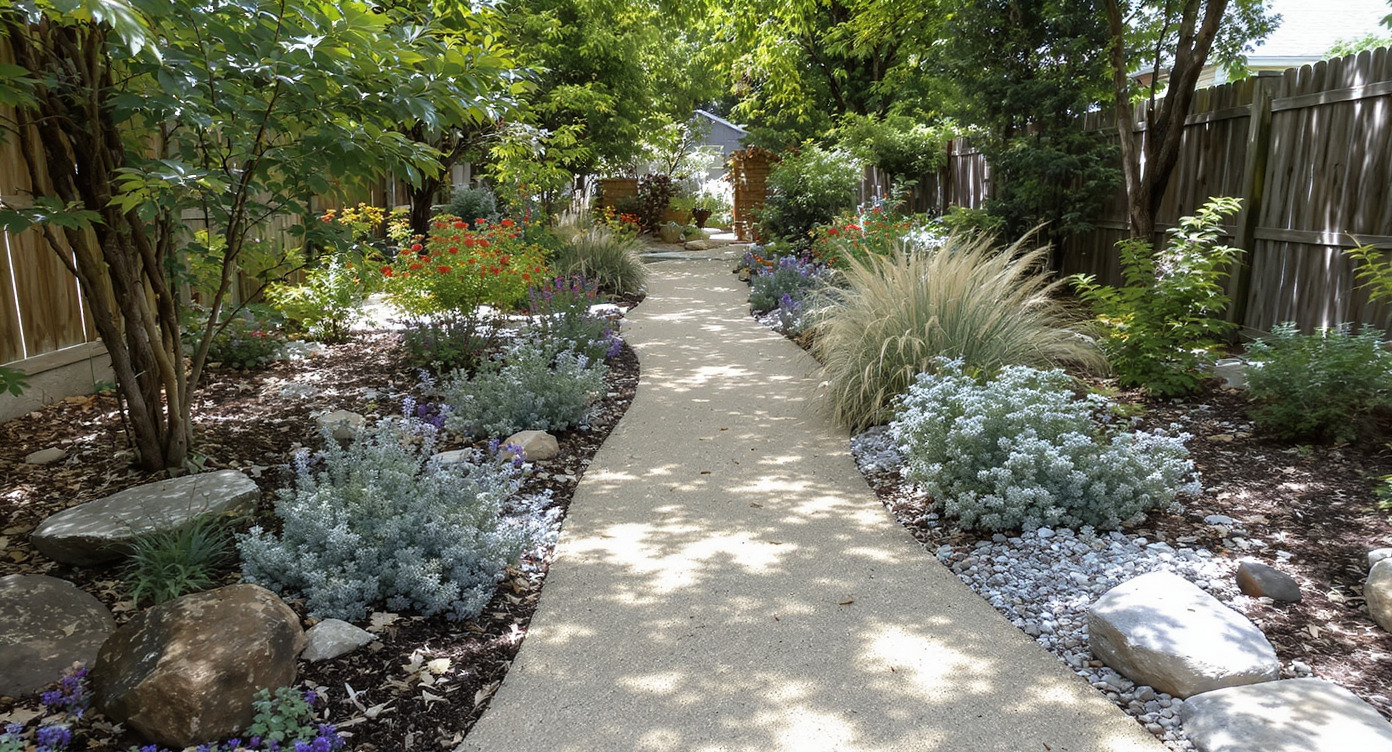
The Five-Minute Reset Path invites calm with a gentle walk through aromatic and textured native plants.
A healing garden is any outdoor (or balcony) space designed to lower maintenance and raise sensory comfort: sight, scent, sound, touch. Think of it like an everyday toolkit. Good healing garden design favors low-maintenance landscaping, right-size plant choices, and small, repeatable chores. Experts recommend six hours of sun for most vegetables and 3–4 hours for many herbs and shade-tolerant perennials; match plants to the light you truly have, not the light you wish you had. Drip irrigation can cut water use by 30–50% compared with overhead sprinklers, and mulching two inches deep can reduce weeding time dramatically. In short, your garden should deliver quiet, not guilt.
Anecdote
I’ve watched a Zone 7 gardener keep going through grief with one habit: she walked her loop, deadheaded one bed, and left the rest for tomorrow. A year later, that loop was a lifeline.
Designs, Tips, And Ideas

Layered plantings and versatile containers create an inviting, low-maintenance healing garden space.
01. The Five-Minute Reset Path
A 24–36 inch wide path lets one person walk comfortably and safely through planting beds.
What it is: A short loop that invites a daily lap, even on busy days.
How it works: Curved lines slow you down, which is the point. Use compacted gravel, wood chips, or stepping stones set 18–24 inches apart. Plant low, brushable edges—thyme, lamb’s ear, dwarf mondo grass—so your hands and ankles feel the texture. Designers often aim for a 60–120 foot loop in a small yard, but even a 20 foot meander between two beds works. In one coastal garden I visit, the owner walks the loop twice before breakfast and says it’s the difference between a frantic and a focused day.
- Mark a route with a hose, then install the path where it naturally lands.
- Edge with three repeating plants for rhythm, like lavender, catmint, and sedum.
- Keep night safety in mind with 10–15 lumen solar stakes set 6–8 feet apart.
02. Container Gardening, Therapy-Sized
Most culinary herbs thrive in 12–16 inch wide containers with 4–6 hours of sun.
What it is: Portable pots for balconies, stoops, and small patios.
How it works: Containers reduce decision fatigue. A trio of pots—one tall, one medium, one low—gives instant structure. Use a peat-free, lightweight mix and water when the top inch of soil is dry. For edible comfort, plant basil, mint (in its own pot), and cherry tomatoes. For scent therapy, try lavender, lemon balm, and rosemary. I’ve seen apartment gardeners create a full “tea bar” on a 3 foot ledge, and the ritual of morning harvest doubles as a mindfulness practice.
- Group pots together to create a microclimate that reduces watering needs.
- Add a saucer and mulch the surface to slow evaporation.
- Choose self-watering containers if heat or time is a concern.
03. The Native Pollinator Patch
Clustering natives in groups of 3–5 improves pollinator foraging and visual impact.
What it is: A small wildflower zone planted for bees, butterflies, and birds.
How it works: Mix nectar and host plants for spring-to-fall bloom. In many USDA zones, coneflower, black-eyed Susan, milkweed, aster, and prairie dropseed create a perennial backbone. Leave a bare soil patch for ground-nesting bees. Keep the patch at least 3x5 feet so insects can find it, and water deeply once a week during establishment. Horticulturists note that even one square meter of native plants can noticeably increase backyard biodiversity.
- Pick 5–7 natives suited to your zone; plant 12–18 inches apart.
- Skip pesticides and use organic mulch, 2 inches deep, pulled back from crowns.
- Delay cutback until late winter to protect overwintering insects.
04. The Low-Maintenance Shrub Backbone
Shrubs spaced at mature width reduce pruning and crowding over time.
What it is: A durable frame of evergreens and flowering shrubs that keeps the garden “up” when life is busy.
How it works: Choose 3–5 species and repeat them. For sun, consider dwarf bayberry, lavender, and butterfly bush; for part shade, oakleaf hydrangea, inkberry holly, and fothergilla. Underplant with long-blooming perennials like salvia and echinacea. Mulch holds moisture and reduces weed pressure; one yearly winter prune handles shape. A homeowner in Zone 7 once told me this simple backbone is what kept her garden looking cared-for during a tough year of family illness.
- Space lavender 18–24 inches, echinacea 12–18 inches, inkberry to mature width.
- Lay 2–3 inches of shredded bark or leaf mold, not piled against stems.
- Install a 1/2 inch drip line with emitters at each root zone.
05. Water-Wise Calm: Drip + Rain
Drip irrigation can reduce water use by up to half compared with overhead sprinklers.
What it is: A simple system that waters plants, not paths.
How it works: Pair a pressure regulator and timer with in-line drip to deliver 1–2 gallons per hour right at the roots. A 50–60 gallon rain barrel can harvest roughly 600 gallons per 1,000 square feet from a single inch of rain, which makes even small storms feel useful. In drought-prone areas, gardeners often water early morning, aiming for one inch per week combined rainfall and irrigation. The quiet click of a timer doing its job removes worry from hot weeks.
- Run drip under mulch to limit evaporation and trip hazards.
- Use a soil moisture meter to avoid overwatering containers.
- Break large zones into 10–15 minute cycles to prevent runoff.
06. The Raised-Bed Kitchen Corner
A 3–4 foot wide bed allows easy reach from both sides without stepping on soil.
What it is: A compact food bed that trades sprawl for order.
How it works: Build a 4x8 foot bed, 10–12 inches deep, fill with compost-rich mix, and aim for 6–8 hours of sun. Plant tomatoes 18–24 inches apart with basil tucked between, trellis cucumbers on the north edge, and interplant fast growers like radishes. Succession sow greens every 2–3 weeks. The neat edges and quick harvests are confidence builders; one client calls this “my daily win” because something is always ready to pick.
- Install a 6 foot trellis on the north side to avoid shading shorter crops.
- Top-dress with 1 inch of compost each spring for steady fertility.
- Keep a narrow 24 inch mulch path around the bed for clean access.
07. Sound, Shade, And A Small Fountain
Moving water masks noise and attracts birds without inviting mosquitoes when kept circulating.
What it is: A quiet corner where shade and sound reduce sensory overload.
How it works: A table-top bubbler or 10–20 watt pump in a glazed pot adds a gentle note you can hear over traffic. Pair with a shade sail or small tree—serviceberry, redbud, desert willow depending on climate—to cool the area by 10–15 degrees Fahrenheit. The combination turns a harsh patio into a usable afternoon refuge. I’ve seen gardeners in hot zones time their day around this spot, coffee at sunrise, tea at dusk.
- Site fountains where you can see and hear them from indoors.
- Place a flat stone as a bird landing pad 1–2 inches above the water.
- Add string lights along the beam of a shade sail for evening decompression.
08. The One-Bed Rule For Overwhelm
Short, 10–15 minute sessions are easier to sustain than occasional marathon workdays.
What it is: A maintenance mindset that protects your mood.
How it works: On hard weeks, commit to just one small task in one defined area: deadhead the perennial border, weed the front path, or water the container garden. Set a timer and stop when it rings. Garden designers often follow a “clockwise lap,” noting needs but fixing only the first urgent one. This rule is how a widower I visit kept gardening through grief—one bed, one day, then rest.
- Keep tools in a weatherproof tote so starting takes 30 seconds.
- Use a kneeler and lightweight pruners to protect joints.
- Write a two-item task list; anything else is a bonus, not a burden.
A Gentle Pivot

Short, regular gardening sessions, not perfection, foster the greatest mental health benefits outdoors.
Short, regular sessions, not perfection, deliver the biggest mental health gains in a garden. The beauty of modern backyard garden ideas is how forgiving they are. You can miss a week, mulch again, and start fresh. You can swap a thirsty lawn for an eco-friendly yard and still host dinner. You can let clover bloom, feed the bees, and call it curb appeal planting. Gardening isn’t a test. It’s a relationship with weather, soil, and time. Field note: In the high desert, I’ve watched gardeners switch to native landscaping and find relief in the first season—less watering, more birds, and a sense that they’re working with their place, not against it.
See It Before You Plant It
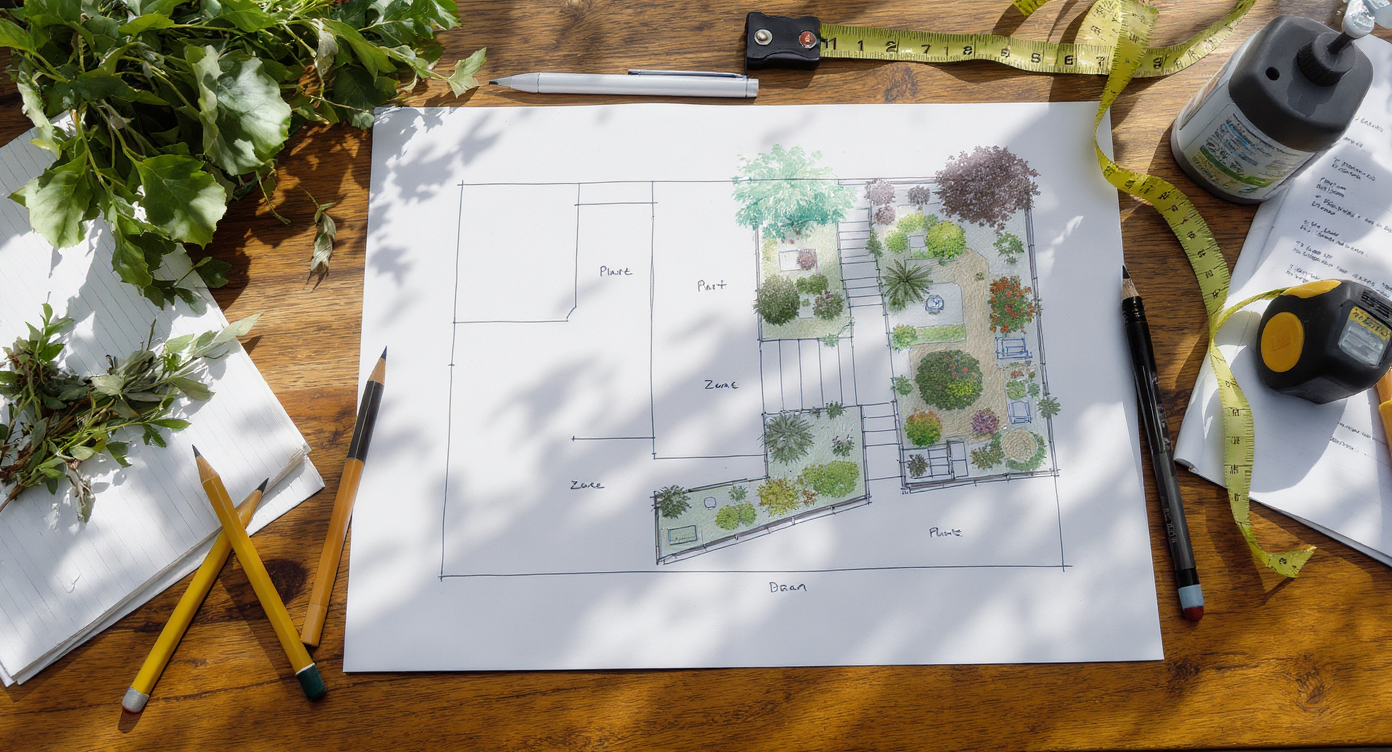
Planning with sketches helps avoid mistakes by visualizing plant placement and garden scale beforehand.
A simple concept sketch prevents the most common mistakes: wrong plant, wrong place, wrong scale. Before you plant a single seed, map your space virtually. Platforms like ReimagineHome let you preview garden layouts, sunlight paths, and color palettes—turning sketches into living blueprints. Import a photo of your yard, test a raised bed kitchen corner or a native pollinator patch, and see how a path actually flows. A few minutes of visualization can save a season of frustration and help you design a healing garden that fits your life now, not “someday.”
Visualization Scenario
Upload a photo of your front yard to ReimagineHome, test a native pollinator strip along the walk, drop in a 4x8 raised bed, and place a shade sail over a small seating area. Compare two color palettes—cool blues vs. sunset oranges—then export the plan with a plant list.
FAQ: People Also Ask
How does gardening improve mental health?
Light activity outdoors, exposure to natural light, and small achievable tasks reduce stress and improve mood for many people. Even 20 minutes of therapeutic gardening a few times per week can provide benefits.
What is a healing garden?
A healing garden is a space planned for sensory comfort and easy care, often using native landscaping, shade, water sound, and low-maintenance plants. Its goal is to make short, restorative visits effortless.
What plants are best for a low-maintenance, stress-free garden?
Designers often recommend tough perennials and shrubs like coneflower, salvias, lavender, sedum, and inkberry holly, matched to your USDA zone and light conditions. Native plant mixes generally require less water and care once established.
How much time should I garden each week for benefits?
Short, regular sessions of 10–20 minutes, three to five times weekly, are easier to sustain and still provide mental health benefits. The “one-bed rule” helps prevent overwhelm.
How do I start a healing garden on a small patio or balcony?
Use container gardening with three to five pots, focusing on herbs and compact edibles with 4–6 hours of sun. A small fountain and a chair can turn a balcony into a therapeutic retreat.
What if gardening makes me anxious when things fail?
Scale down, switch to resilient plants, and automate watering with drip or self-watering containers. Focus on one small area and celebrate quick wins to rebuild confidence.
A Closing Walk
Gardens don’t cure life, they companion it. On morning rounds, I brush past thyme and hear the low buzz of bees in the salvias. I’ve seen teenagers beam over their first sunflower, and I’ve walked with new parents who only had ten minutes between naps—and that was enough. When anxiety spikes, a five-minute reset path is a lifeline. When loss comes, planting bulbs can be a promise to your future self. In 2025, therapeutic gardening is less about flawless borders and more about belonging to a place. Build the pieces that steady you, and let the rest wait. Plants are patient; be patient with yourself, too. Visualize your next step with ReimagineHome, then take it outside.
.svg)

.svg)

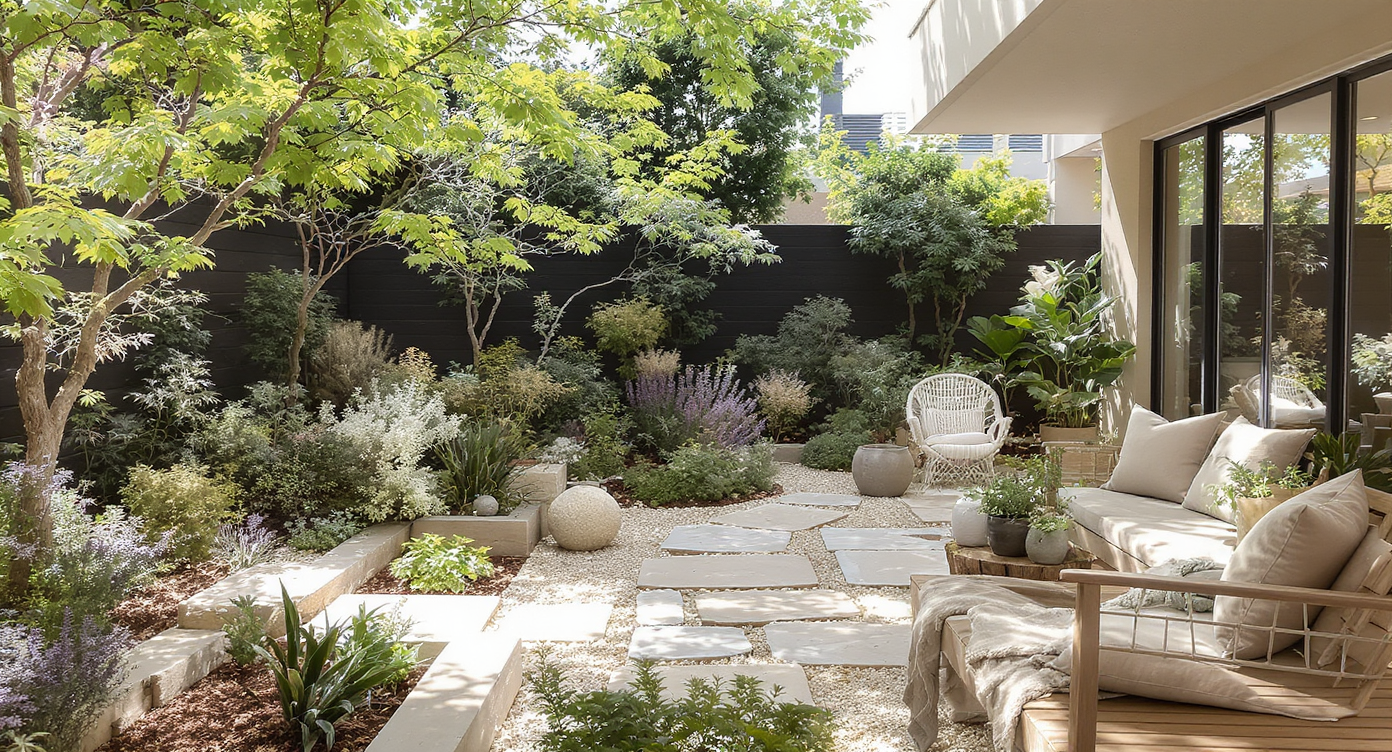

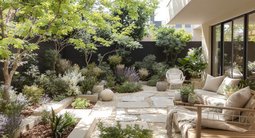


.png)